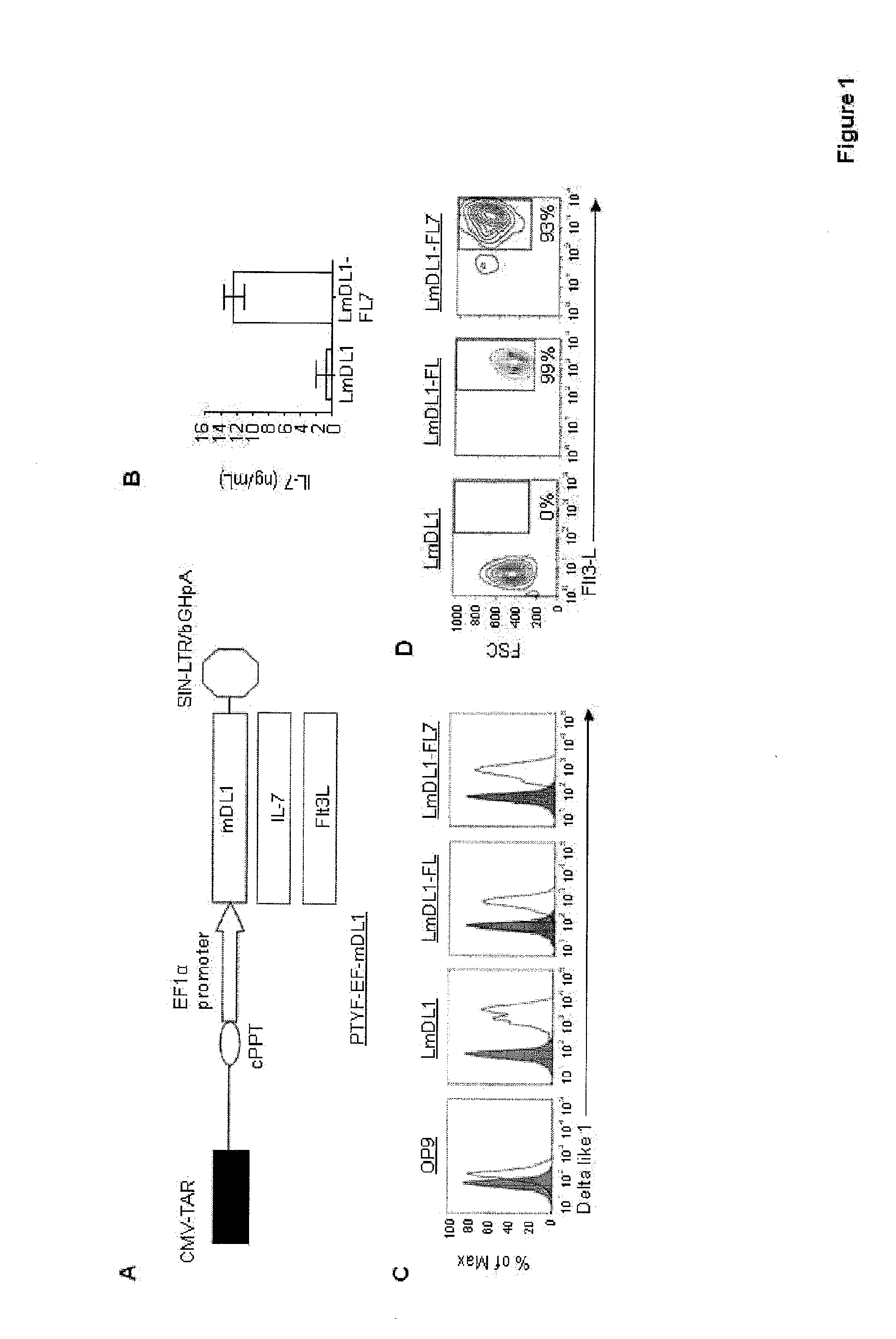System and method for producing t cells
a technology of t cells and systems, applied in the field of system and method for producing t cells, can solve the problems of limited success in generating fully mature t cells, laborious and difficult to manipulate in vitro culture systems for producing human t lymphocytes such as thymus organ cultures and three-dimensional matrices of epithelial cells, and achieve the effect of enhancing pret cell expansion
- Summary
- Abstract
- Description
- Claims
- Application Information
AI Technical Summary
Benefits of technology
Problems solved by technology
Method used
Image
Examples
example 1
Increased Expansion of Early T Lymphocytes from Adult Human CD34+ Progenitors in a Simplified Lentiviral Vector-Modified Stromal Culture System
[0034]We have previously reported, that a lentiviral vector-modified mouse fetal stromal cell line (LmDL1) expressing mouse delta-like 1 ligand (DL1) can support early T cell differentiation of human CD34+ HPC from cord blood, fetal thymus, fetal liver and adult bone marrow (16). To develop a culture system with a stable cytokine environment independent of exogenously added growth factors, we further transduced the LmDL1 cells with lentiviral vectors expressing human Flt3L, or both Flt3L and IL-7, to generate LmDL1-FL and LmDL1-FL7 cell lines, respectively (FIG. 1A). The secretion of IL-7 by LmDL1-FL7 was measured via ELISA to be in the range of 10-14 ng / mL after 48 hours of culture (FIG. 1B). The surface DL1 expression on all three lentiviral vector-transduced cell lines (LmDL1, LmDL1-FL and LmDL1-FL7) was substantially higher than that of t...
example 2
LmDL1-FL7 Cell Line does not Support Differentiation of BM CD34 HPC into Fully Mature T Cells
[0037]The transition of differentiating T cells from double negative (DN) to DP stage and CD4 and CD8 lineages requires Notch signaling as well as pre-TCR signaling (22, 23). The DP T cells depend exclusively on signals downstream of TCR for survival; at this stage they become unresponsive to cytokine induced survival signals (24, 25). We observed that the T cell precursors expressed CD3 but died after about 40 days in the IL-7, Flt3L and Notch signaling coculture (FIG. 2 C). To see if these developing T cells can become mature SP T cells, we provided these T cells with TCR signals by using anti-CD3 / anti-CD28 microbeads on day 42 (FIG. 2 D). Following the CD3 / CD28 stimulation, the cells expressed low levels of CD8 on the surface. As mature T cells express CD3, TCRαβ and co-stimulatory molecule CD28, and lack CD1a (26), we examined these markers on the developing CD8 SP cells. Antibody staini...
example 3
Increased Differentiation from Pre-T to DP T Cells after IL-7 Removal
[0038]The above results showed that the LmDL1-FL7 culture system does not support differentiation of ISP to DP T cells and full maturation of T cells. In the coculture, only a small percentage of CD3+ T cells coexpressed low levels of TCRαβ .suggesting improper TCR rearrangement or processing. FIG. 2 {tilde over (B)}. Down-regulation of IL-7 receptor signaling is required for further differentiation of pre-T lymphocytes in mice as it interferes with the transcription factors that are required for maturation to CD4CD8 DP stage (27-30). Even though the IL-7 signaling is blocked in DP T cells, these cells reside in a thymic compartment with minimal IL-7 producing cells (31). We hypothesized that efficient T cell differentiation to DP stage in humans might be promoted by removing IL-7 after the appearance of ISP cells. To test this, we cultured adult human BM CD34+ cells in LmDL1-FL7 for 24 days and then transferred th...
PUM
| Property | Measurement | Unit |
|---|---|---|
| time | aaaaa | aaaaa |
| time | aaaaa | aaaaa |
| time | aaaaa | aaaaa |
Abstract
Description
Claims
Application Information
 Login to View More
Login to View More - R&D
- Intellectual Property
- Life Sciences
- Materials
- Tech Scout
- Unparalleled Data Quality
- Higher Quality Content
- 60% Fewer Hallucinations
Browse by: Latest US Patents, China's latest patents, Technical Efficacy Thesaurus, Application Domain, Technology Topic, Popular Technical Reports.
© 2025 PatSnap. All rights reserved.Legal|Privacy policy|Modern Slavery Act Transparency Statement|Sitemap|About US| Contact US: help@patsnap.com



